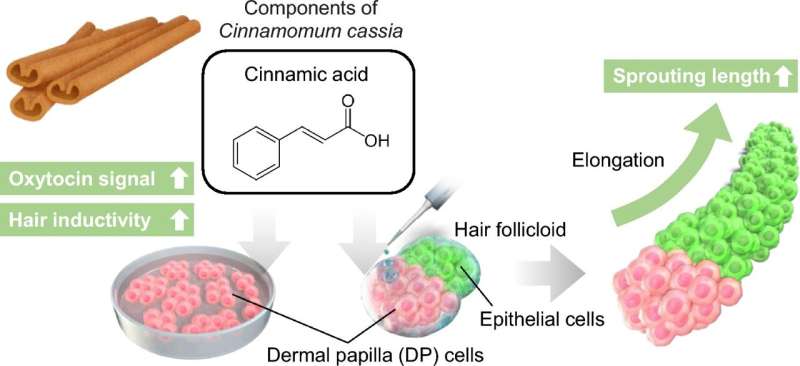Cinnamic acid treatment increased the sprouting length of hair follicle organoids, suggesting that cinnamic acid promoted hair growth. Credit: Scientific Reports (2024). DOI: 10.1038/s41598-024-55377-y
Hair has a significant impact on how society and we, as individuals, see ourselves. Consequently, hair loss or alopecia causes considerable emotional distress and anxiety and often results in a reduced quality of life for those suffering from its effects. Most alopecia patients choose drug therapy as their first treatment option. Currently, there are drugs that are effective in improving some symptoms of alopecia. However, these drugs often have side effects, and their efficacy may vary widely.
Therefore, new, more effective agents are needed to address this issue. Recent research at Yokohama National University in Japan on oxytocin shows promise in promoting hair growth in human hair follicles. However, oxytocin itself is too large a molecule to be absorbed by our skin, and it breaks down too quickly for use.
Consequently, researchers have turned their attention to cinnamic acid, a small molecule that can activate oxytocin receptor expression. They found that treatment with cinnamic acid led to an increase in the expression of oxytocin receptors, thereby allowing more oxytocin into the system and increasing hair growth gene expression in human dermal papilla cells, the mesenchymal cells in hair follicles.
"These promising results may be useful for developing hair growth-promoting products targeting oxytocin," said Junji Fukuda, the paper's corresponding author and a professor at the Faculty of Engineering, Yokohama National University, Yokohama, Kanagawa Prefecture, Japan.
This research was published in Scientific Reports.
The initial research into oxytocin found that it upregulated, or increased, the expression of the genes associated with hair growth in the dermal papilla cells. Although oxytocin itself was not a good candidate for topical application as a hair treatment, its effect was too useful to discard. The Japanese researchers, therefore, looked at cinnamic acid, which also works in the oxytocin signaling pathway and might act to increase the oxytocin and thereby increase hair growth.
To test this theory, they grew dermal papilla cell cultures in varying concentrations of cinnamic acid. "At concentrations below 500 μg/mL, we observed a dose-dependent increase in the expression of oxytocin receptor expression and the genes associated with hair growth," said Tatsuto Kageyama, the paper's first author and an assistant professor in the Faculty of Engineering, Yokohama, National University, Yokohama, Kanagawa Prefecture, Japan.
The best method to test the efficacy of a new hair growth-promoting treatment would be to use hair follicles harvested from patients and grown in culture with the new treatment. This is the closest to testing on humans you could get without testing on humans. However, collecting enough samples and, with the variability between individuals, getting dependable results in numbers large enough to have significance is very difficult.
In response to this issue, the Yokohama lab developed hair follicloids, which are hair follicles built from cells taken from multiple hair follicles that can then be grown in culture. Allowing a known range of different cells to be exposed to the treatment gives much larger and more dependable data.
The follicloids do not grow mature hair. Instead, they grow hair shaft-like structures. When the follicloids were grown in culture with the cinnamic acid, a 1.25-fold increase in the length of the shaft-like structures was observed. This is just slightly below the 1.3-fold increase found in their previous study on oxytocin, showing that cinnamic acid has close to the same hair growth effect as oxytocin.
Future research will concentrate on doing in vivo studies with mice that exhibit hair loss to determine the efficacy of transdermal application, as well as dosage, and to elucidate any side effects.
"The identification of cinnamic acid as a specific component with hair growth-promoting properties holds great promise for enhancing the effectiveness of hair growth products. In addition, the new understanding of the mechanism of hair growth-promoting effects mediated by oxytocin signaling will provide new insights by hair care science and help accelerate the search for new drugs targeting oxytocin receptor expression in the field of drug discovery," Kageyama said
More information: Tatsuto Kageyama et al, Cinnamic acid promotes elongation of hair peg-like sprouting in hair follicle organoids via oxytocin receptor activation, Scientific Reports (2024). DOI: 10.1038/s41598-024-55377-y
Journal information: Scientific Reports
Provided by Yokohama National University
























